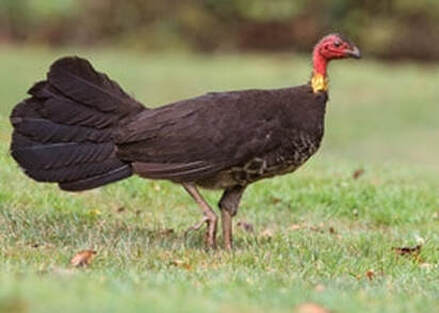Last summer I was fascinated to see a brush turkey mound just south of the surf club car park at Bennett’s Beach.
You could watch the male busily adjusting the temperature by adding or removing mulch from the mound, ever mindful of the exact conditions the eggs require to hatch. This process is most unconventional for birds.
Rather than using the body heat of a sitting bird to hatch their eggs, these animals use the heat generated by decaying vegetable matter within the nest mound.
Their huge feet are perfect for the ongoing scraping required for temperature regulation. A constant range of 33 to 38 degrees is critical to success. Above or below this band will always result in the loss of the chicks. The bird's bill is used as a thermometer, constantly monitoring the heat of the mound.
Even before they are hatched the chicks are vulnerable, goannas and other predatory animals are a constant threat the male adult must guard against.
Once hatched however, the young are rather well-equipped for survival and this is most fortunate because the ever-protective father will then suddenly leave.
From then on, the chicks are on their own. From the start they are fully feathered, are able to walk and can fly within a few hours of their entry into the world.
The Australian brush-turkey is presently enjoying a rise in population and distribution, having successfully adapted to the suburbs and to recent changes in human behaviour.
It loves our mulch- covered native gardens – the perfect place to build its mound.
Also, most dogs are now contained within properties and ideally most cats as well, so a significant hazard to chick-raising has now diminished.
Insects, seeds and fallen fruit are their main foods and they obtain these by raking through leaf litter or breaking open rotting logs.For this their over-large feet again become most useful.
Generally they are wary of humans although they can become very tame around picnic grounds and homes, particularly if they are fed. Feeding them, or any native animal, is not recommended.
Brush turkeys are not every gardener's first passion since they can be destructive. Within a few hours these birds are capable of stripping away ground covers and mulch, with which to build their mounds and not everyone enjoys having a nest mound as a dominant garden feature.
When this happens, the attraction of having one of these wonderful birds living on a property can lose its fascination.
Some methods to deter them could be useful, provided that they are implemented when there are no eggs within the mound. A search on line will provide a range of practical methods you could employ, so that your garden remains your garden and the ever-interesting brush turkeys are unharmed and free to reproduce elsewhere.
You could watch the male busily adjusting the temperature by adding or removing mulch from the mound, ever mindful of the exact conditions the eggs require to hatch. This process is most unconventional for birds.
Rather than using the body heat of a sitting bird to hatch their eggs, these animals use the heat generated by decaying vegetable matter within the nest mound.
Their huge feet are perfect for the ongoing scraping required for temperature regulation. A constant range of 33 to 38 degrees is critical to success. Above or below this band will always result in the loss of the chicks. The bird's bill is used as a thermometer, constantly monitoring the heat of the mound.
Even before they are hatched the chicks are vulnerable, goannas and other predatory animals are a constant threat the male adult must guard against.
Once hatched however, the young are rather well-equipped for survival and this is most fortunate because the ever-protective father will then suddenly leave.
From then on, the chicks are on their own. From the start they are fully feathered, are able to walk and can fly within a few hours of their entry into the world.
The Australian brush-turkey is presently enjoying a rise in population and distribution, having successfully adapted to the suburbs and to recent changes in human behaviour.
It loves our mulch- covered native gardens – the perfect place to build its mound.
Also, most dogs are now contained within properties and ideally most cats as well, so a significant hazard to chick-raising has now diminished.
Insects, seeds and fallen fruit are their main foods and they obtain these by raking through leaf litter or breaking open rotting logs.For this their over-large feet again become most useful.
Generally they are wary of humans although they can become very tame around picnic grounds and homes, particularly if they are fed. Feeding them, or any native animal, is not recommended.
Brush turkeys are not every gardener's first passion since they can be destructive. Within a few hours these birds are capable of stripping away ground covers and mulch, with which to build their mounds and not everyone enjoys having a nest mound as a dominant garden feature.
When this happens, the attraction of having one of these wonderful birds living on a property can lose its fascination.
Some methods to deter them could be useful, provided that they are implemented when there are no eggs within the mound. A search on line will provide a range of practical methods you could employ, so that your garden remains your garden and the ever-interesting brush turkeys are unharmed and free to reproduce elsewhere.
Photos and some information NSW Environment. Energy and Science
By Jill Madden
Myall Koala Environment Group
October 2021
By Jill Madden
Myall Koala Environment Group
October 2021



